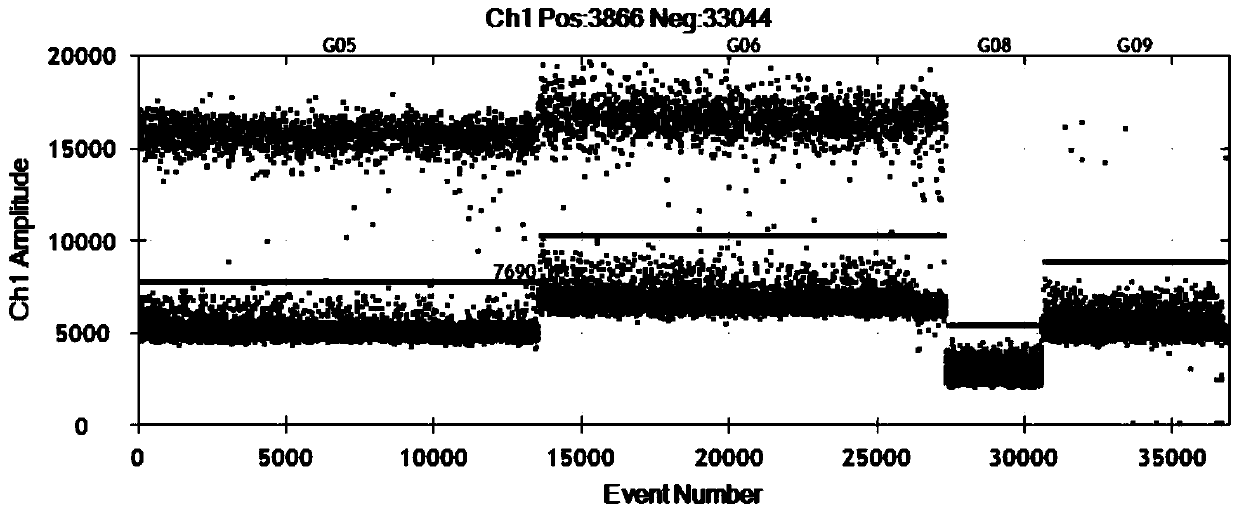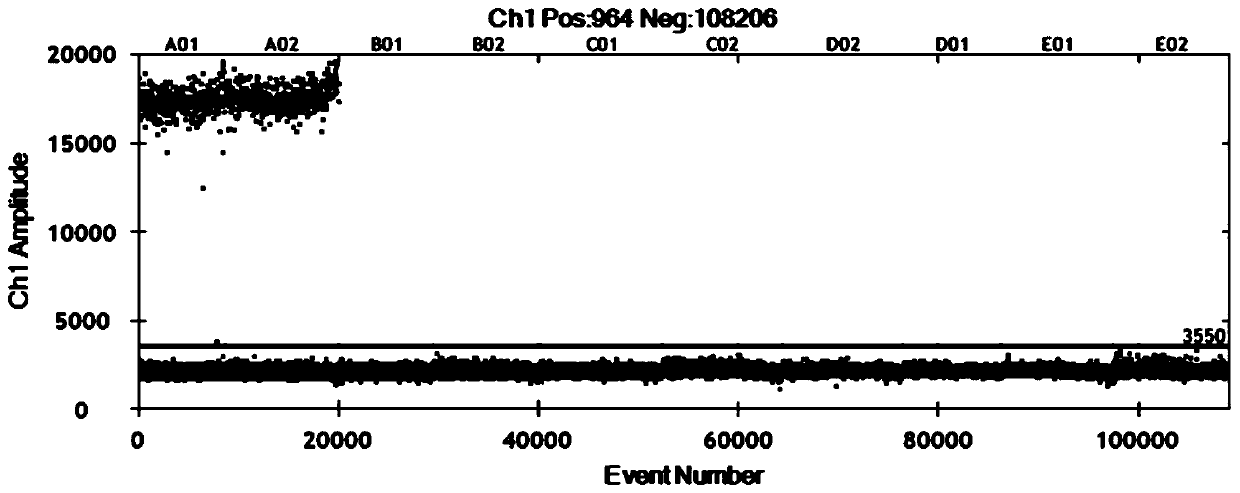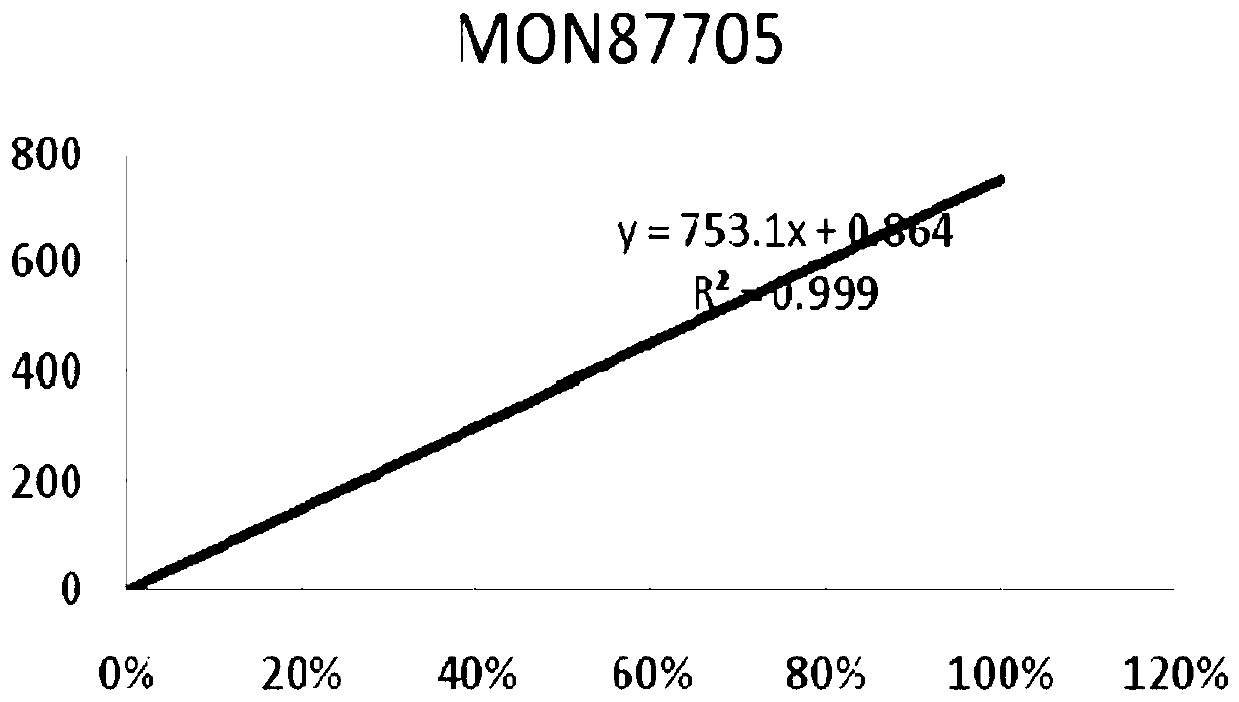PCR (polymerase chain reaction) primer composition to detect transgenic soybean line MON87705 and application thereof
A technology of MON87705 and transgenic soybeans, which is applied in DNA/RNA fragments, recombinant DNA technology, microbial measurement/inspection, etc., can solve problems such as large limitations and difficulty in achieving standard concentration gradients, and achieve good specificity
- Summary
- Abstract
- Description
- Claims
- Application Information
AI Technical Summary
Problems solved by technology
Method used
Image
Examples
Embodiment 1
[0042] Example 1, Digital PCR Quantitative Detection Method for Exogenous Genes of Transgenic Soybean MON87705 Line
[0043] 1. Design of primers and probes
[0044] According to the specific sequence of the transgenic soybean MON87705 strain (that is, the sequence at both ends of the insertion site of the foreign gene at the 5' end of the soybean genome), several different PCR-specific primer pairs and specific probes matching the amplification products of each primer pair were designed, At the same time, a PCR-specific primer pair of the soybean internal reference gene Lectin and a specific probe matching the amplification product of the primer pair were designed. The two probes for different target genes used different reporter fluorescent groups FAM and VIC, and the same The quencher group is labeled with BHQ1; the sequence information of each primer and probe is shown in Table 1.
[0045] Table 1. Primer and probe sequences
[0046]
[0047]
[0048] 2. Quantitati...
Embodiment 2
[0056] Embodiment 2, specific detection
[0057] Different from conventional PCR and qPCR, the specificity can be observed through electrophoretic bands and melting curves respectively. Digital PCR observes the end-point fluorescence in each system. Regardless of whether the PCR product is a specific product, as long as the fluorescence signal is strong enough, it will also be Interpreted as a positive result. Therefore, the primer specificity requirements of dPCR are extremely high. This embodiment uses the optimal combination in Example 1: primer pair B1-F / R and its probe B1 and primer pair A-F / R and its probe A, according to Example 1 In the ddPCR detection method, the genomic DNA of five different transgenic soybean lines MON87705, MON87701, MON87769, DP356043, and DAS68416 standards were detected.
[0058] Result: if figure 2 As shown, the exogenous gene in the standard product of the transgenic soybean line MON87705 has amplified signal, but there is no signal of exog...
Embodiment 3
[0059] Embodiment 3, sensitivity detection
[0060] For the detection of genetically modified ingredients (ie, exogenous genes), the detection of genetically modified ingredients with a low percentage content is the focus and difficulty of the detection of genetically modified ingredients. This example studies the lower limit of double digital PCR detection.
[0061] The genomic DNA of the 50ng / μL transgenic soybean line MON87705 standard was diluted with water, and the relative mass percentages were 100%, 50%, 25%, 5%, 0.5% and 0.05% of the transgenic soybean samples, using the most Excellent combination: primer pair B1-F / R and its probe B1 and primer pair A-F / R and its probe A, according to the ddPCR reaction system and conditions of Example 1, the sensitivity detection of double digital PCR was carried out.
[0062] Results: The quantitative results of the transgenic components of MON87705 are shown in Table 3, and the results of the linear fitting standard curve are shown...
PUM
 Login to View More
Login to View More Abstract
Description
Claims
Application Information
 Login to View More
Login to View More - R&D
- Intellectual Property
- Life Sciences
- Materials
- Tech Scout
- Unparalleled Data Quality
- Higher Quality Content
- 60% Fewer Hallucinations
Browse by: Latest US Patents, China's latest patents, Technical Efficacy Thesaurus, Application Domain, Technology Topic, Popular Technical Reports.
© 2025 PatSnap. All rights reserved.Legal|Privacy policy|Modern Slavery Act Transparency Statement|Sitemap|About US| Contact US: help@patsnap.com



